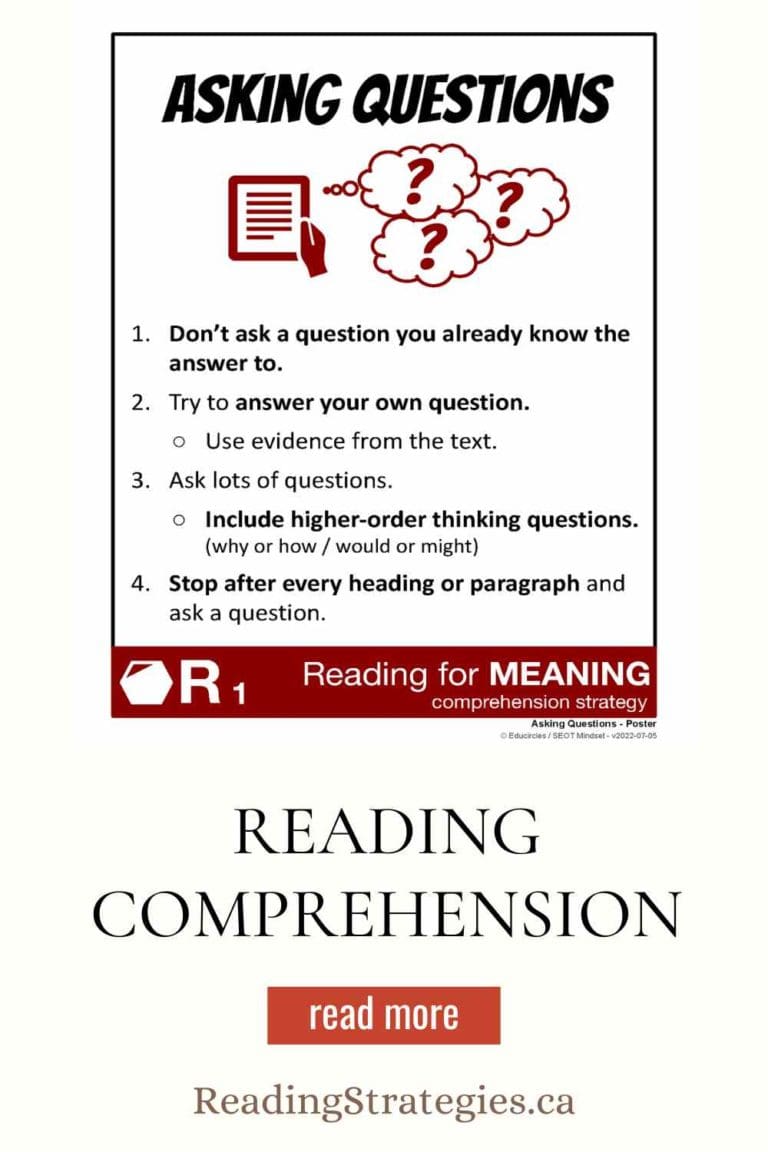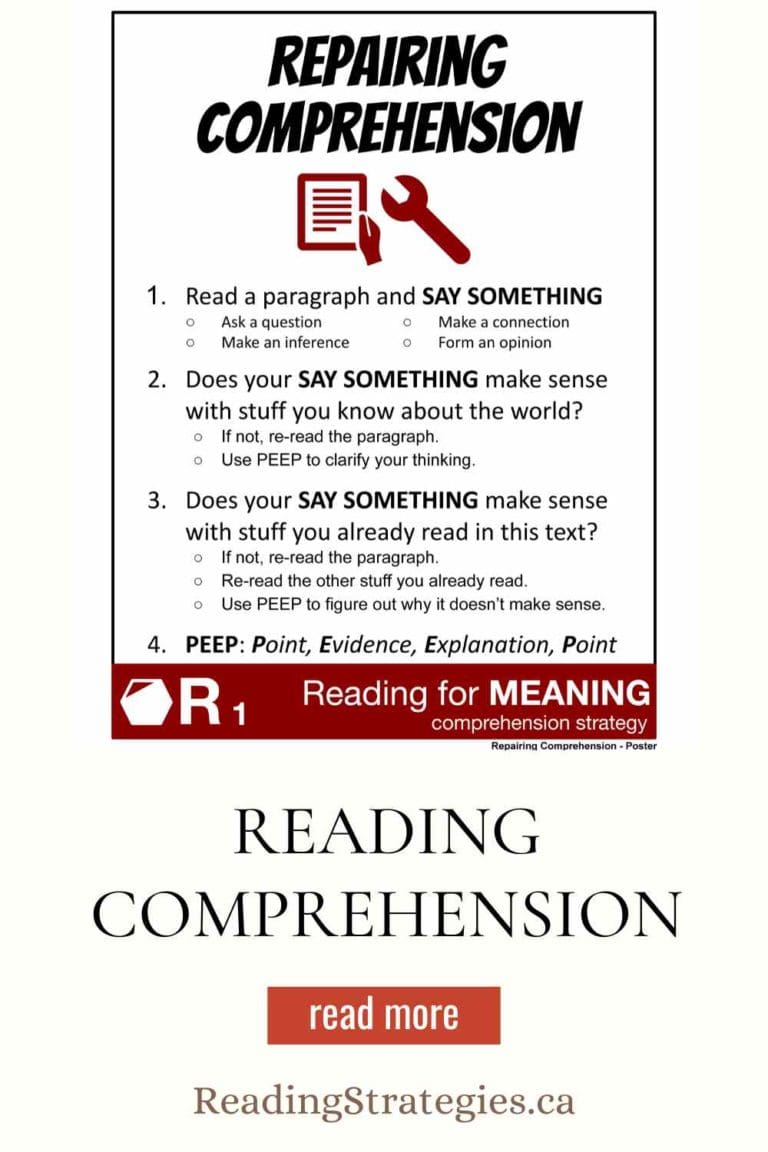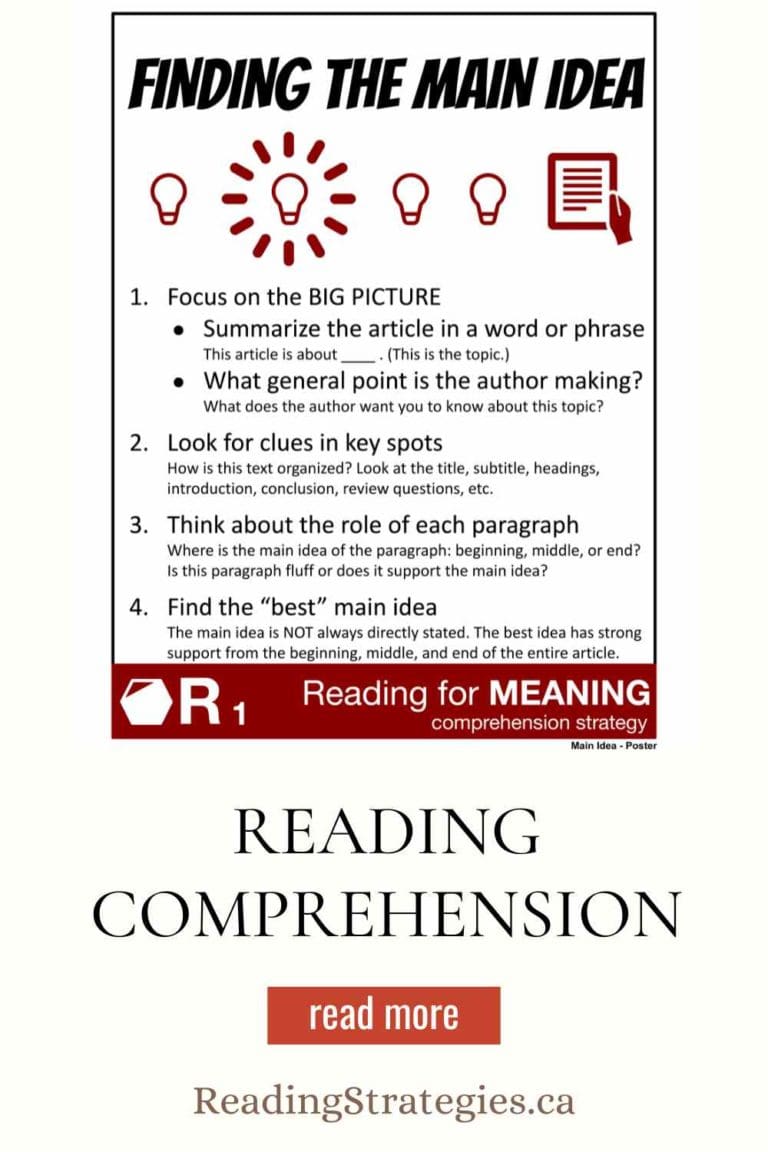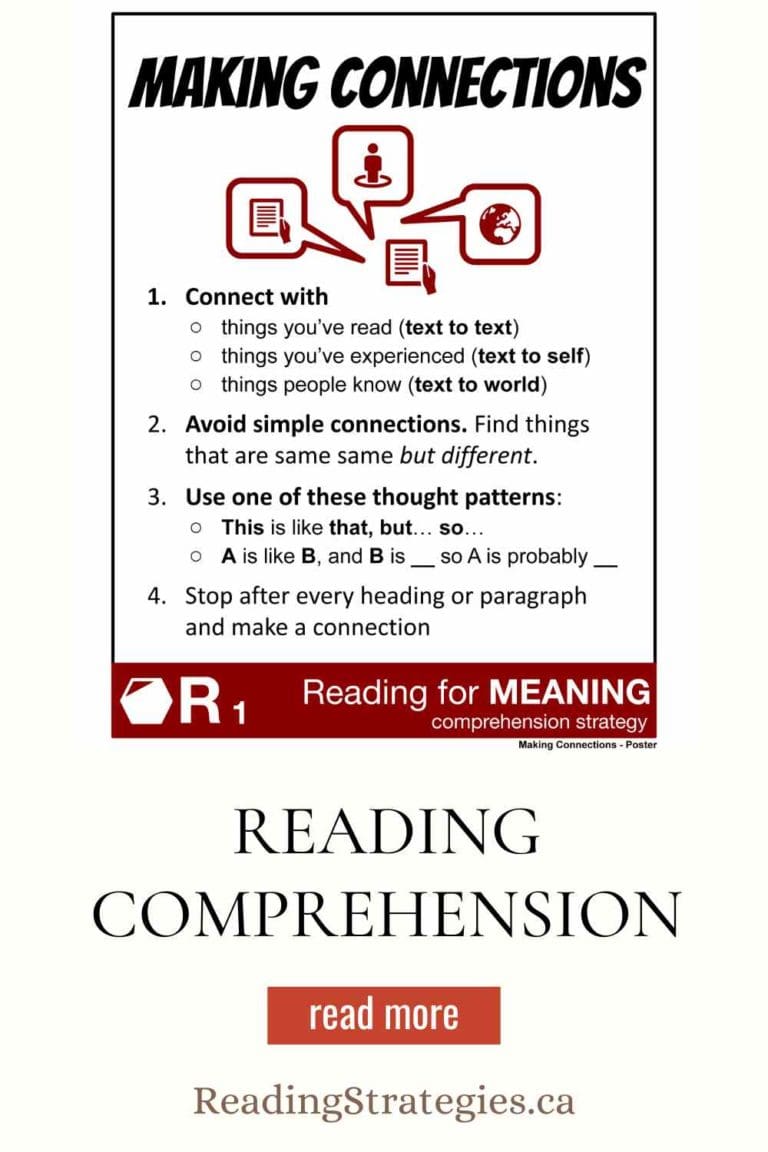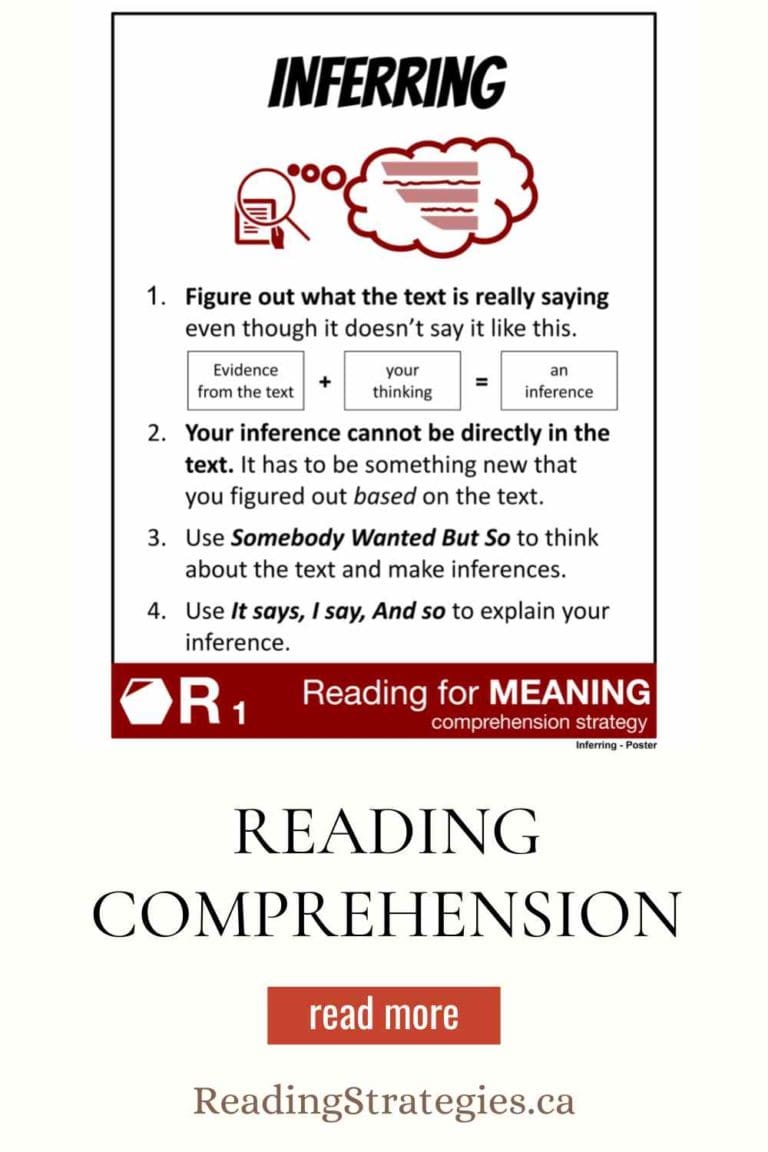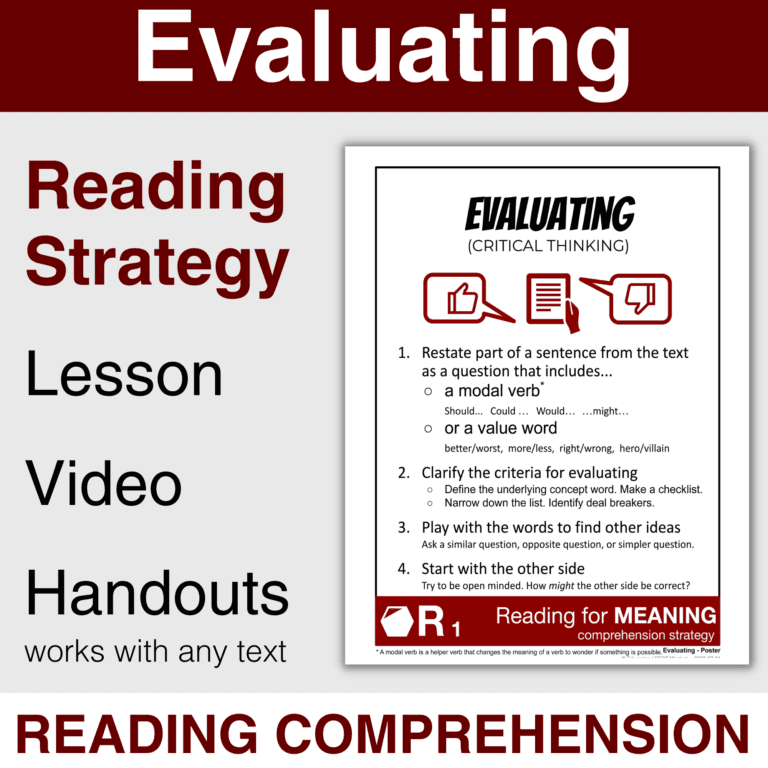
The Active Reading Strategies Lesson includes strategies and handouts that work with any text!
UPDATE: Dec 19, 2022
Improve reading comprehension with just the click of a button!
(No, obviously not. But, Evaluating is one of the reading strategies explored in the “Say Something” handout.)
FREE until Dec 19, 2022 at 11:59 PM
Part 1. Show students how to actively engage with a text
The first handout looks at showing students what strong readers do when they read.
If you’re a struggling reader, you might think that some people are good at reading, and some people aren’t.
But, in fact, strong readers use strategies to help them understand what the text is about.
We often don’t explicitly talk about what we are thinking about. So, this active reading strategies lesson is about making the invisible process more visible.
Doing a “Say Something” can help everyone see the thinking that goes behind active reading.
Active Reading Strategies lesson – Handout #1: Say Something
The “Say Something” handout briefly goes over six reading strategies.
- 1. Ask high-level thinking questions
- 2. Make deeper connections
- 3. Infer what the author is really saying.
- 4. Evaluate and form an opinion.
- 5. Find the Main Idea. (This is really about…)
- 6. Repairing Comprehension (Oh, I get it…)
(NOTE: If you want more in-depth lessons for each reading strategy, check out the mega bundle.)
What’s nice about the “Say Something” handout is that it breaks down each reading strategy into two parts:
- What to say (i.e., Sentence stems)
- What to do (i.e. Pro tips)
Part 2. Get Reading Comprehension Marks from Students: Diagnostic, Formative, and Summative Assessment)
In this active reading strategies lesson power-up, students demonstrate their (current) understanding of the text in TWO WAYS, so you can observe, assess, or evaluate.
- Oral Communication by playing Idea Volleyball (handout 2.)
- Written Communication by using the Double-Entry Journal (handout 3.)
IMPORTANT: Text NOT included.
Use the Active Reading Strategy Lesson handouts with whatever text you’re currently studying in the classroom right now!
This resource can be used to analyze any text (printed text):
- novels,
- articles,
- poems,
- etc.
It can also be adapted to use with any media text:
- TED talks,
- songs,
- movies,
- podcasts,
- etc.
Note: If you use the “Say Something” handout with a media text, then instead of reading the text, you simply watch a few minutes of the TED talk together.
IMPORTANT: Rubric NOT included.
This resource provides a framework for students to actively engage with the text and demonstrate their understanding.
This means you can use whatever marking scheme you already have.
Here’s what you get with this ACTIVE READING strategies resource:
- Slideshow Lesson,
- Video (coming soon)
- Handouts that work with any text
- Digital Learning format (Easel by TPT™)
FREE FOR A LIMITED TIME!
- This product is currently free for 24 hours to thank people who follow my store or subscribe to my email newsletter. Sign up for the newsletter here to get free stuff!
- After Mon Dec 19, 2022 (11:59 PM ET), this will become a PAID PRODUCT and cost $3.00
- I am currently recording a YouTube video that will you through the entire slideshow lesson. When this video is published, the price of this resource will increase.
This product includes:
- PDF handouts.
- Google Docs™ / Microsoft Word™ versions of the handouts to edit.
- Google Slides™ / Microsoft Powerpoint™ versions of the slideshow lesson.
- Easel by TpT™ digital version.
(Learn more about the FREE Easel by TPT platform here.)
This product is SIMPLE AND STRAIGHTFORWARD to use!
- Look at the ACTIVE READING – PREVIEW PDF to see exactly what you get.
How to do a SAY SOMETHING (Active Reading Strategy)
GET READY
You need:
- The “Say Something” handout
- Something to read “the text”
OVERVIEW
STEP 1: Read a paragraph of the text.
STEP 2: Say something about what you just read. Use one of the reading strategies on the handout.
- Strategy #1 ASK a question
- Strategy #2 Make a CONNECTION
- Strategy #3 INFER and figure out what the text is really saying
- Strategy #4 EVALUATE and form an opinion
- Strategy #5 Find the MAIN IDEA
- Strategy #6 Oh, I get it… REPAIR COMPREHENSION
STEP 3: If you can’t do a “say something,” then go back, slow down, and re-read the paragraph.
EXAMPLE
STEP 1: Read a paragraph of the text.
- “Sky high”
- “Keeping a level head when anxiety is sky high.”
STEP 2: Say something about what you just read. Use one of the reading strategies on the handout.
- Uhh…
STEP 3: If you can’t do a “say something,” then go back, slow down, and re-read the paragraph.
Example – ASKING QUESTIONS
- Why would flying “sky high” be a good thing?
- Maybe because you can see things far away because you’re so high up?
Example – MAKING CONNECTIONS
- “Keeping a level head when anxiety is sky high”
- Keeping a level head is kind of like staying at the top of the leaderboard in a video game
- Keeping your high score and rank is hard the higher you get…
- So maybe keeping calm is hard when you get super anxious?
Example – INFERRING
Try to do a “Somebody Wanted But So”:
- A passenger
- wanted to go for a ride in a jet plane…
- … but discovered they were afraid of flying …
- … so the pilot landed the plane.
Example – EVALUATING
- Is being afraid of heights better than being afraid of what people think of you?
- I don’t think either fear is “better.”
- But if I had to choose, I’d rather be afraid of heights because then you could just stay on the ground
Example – FINDING THE MAIN IDEA
The BEST main idea is supported by evidence throughout the text (beginning, middle, and end)
The title can be a great spot to start looking for clues. But we’ll have to keep reading to see if our ideas are correct…
- I think this article might be about flying
- The author might be saying that flying is scary
Example – REPAIRING COMPREHENSION
- Oh, I get it…
- At first, I thought it was about flying a plane really high…
- … but now I think it’s about keeping the plane flat (level) during turbulence
- … maybe there’s a storm that makes even the pilot scared!
ACCOUNTABILITY
Accountability means being… “required or expected to justify actions or decisions”
- In other words, do the work…
- And show the teacher what you did…
- to demonstrate your current level of understanding
GET READY
You need:
- A place to take notes (i.e. the “Double-entry journal” or the Reading Strategy handout)
- “Idea Volleyball” handout
OPTION 1: Take Notes (i.e. Using the Double-Entry Journal)
Jot down notes to show your thinking process. (Written Communication)
After you do a “Say Something”
- On the left side of the T-chart, write down the words or phrase that inspired the “say something”
- On the right side of the T-chart, jot down the ideas that came up during your “say something”
A few pro tips:
- You might have several “snippets” of evidence from the text to support your thinking.
- The goal is not to have perfect answers.
- You want to show how your understanding changes over time
In other words, there’s no need to go back and “fix” your answers because repairing comprehension shows that you are learning … which is the point of this handout
OPTION 2: Play “Idea Volleyball”
Play Idea Volleyball to show your thinking process (Oral Communication.)
Sometimes, students don’t know what to say when they’re working with a partner.
“Idea Volleyball” is a process to help students develop a more complex idea
STEP 1:
- Partner A reads a paragraph of the text out loud.
STEP 2
- As Partner A reads, they are actively thinking about what they could say about the text.
STEP 3
- After Partner A reads the paragraph, they do a “Say Something.”
- (If Partner A can’t do a “Say Something,” they have to go back and re-read the paragraph.)
STEP 4
- Partner B has to respond to what Partner A says.
- GAME OVER: If Partner B wasn’t paying attention and just says their own thing, then they missed the idea ball. Don’t let the idea fall to the floor.
- GAME ON! Partner B adds to the conversation by doing a “Say Something”
STEP 5
- Partners A and B go back and forth, adding to the conversation each time.
- Do you agree or disagree with what your partner said?
- Can you build on the idea with more evidence from the text?
- The point of “Idea Volleyball” is to bounce around ideas to develop a deeper understanding.
- How complex of an idea can you develop?
- In other words, how many times can you bounce the idea back and forth (before having to serve a new idea?)
STEP 6
- Once you run out of things to say (about Partner A’s idea)…
- Then, Partner B starts with a different “Say Something.”
Once both partners have done a “Say Something” with the text that Partner A read out loud…
… it’s now the other partner’s turn to read the next paragraph and the game begins again.
STEP 1
- Partner B reads a paragraph of the text out loud…
